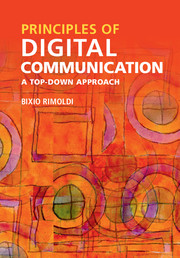Book contents
- Frontmatter
- Dedication
- Contents
- Preface
- Acknowledgments
- List of symbols
- List of abbreviations
- 1 Introduction and objectives
- 2 Receiver design for discrete-time observations: First layer
- 3 Receiver design for the continuous-time AWGN channel: Second layer
- 4 Signal design trade-offs
- 5 Symbol-by-symbol on a pulse train: Second layer revisited
- 6 Convolutional coding and Viterbi decoding: First layer revisited
- 7 Passband communication via up/down conversion: Third layer
- Reference
- Index
2 - Receiver design for discrete-time observations: First layer
Published online by Cambridge University Press: 05 January 2016
- Frontmatter
- Dedication
- Contents
- Preface
- Acknowledgments
- List of symbols
- List of abbreviations
- 1 Introduction and objectives
- 2 Receiver design for discrete-time observations: First layer
- 3 Receiver design for the continuous-time AWGN channel: Second layer
- 4 Signal design trade-offs
- 5 Symbol-by-symbol on a pulse train: Second layer revisited
- 6 Convolutional coding and Viterbi decoding: First layer revisited
- 7 Passband communication via up/down conversion: Third layer
- Reference
- Index
Summary
Introduction
The focus of this and the next chapter is the receiver design. The task of the receiver can be appreciated by considering a very noisy channel. The “GPS channel” is a good example. Let the channel input be the electrical signal applied to the transmitting antenna of a GPS satellite orbiting at an altitude of 20 200 km, and let the channel output be the signal at the antenna output of a GPS receiver at sea level. The signal of interest at the output of the receiving antenna is very weak. If we were to observe the receiving antenna output with a general-purpose instrument, such as an oscilloscope or a spectrum analyzer, we would not be able to distinguish the signal from the noise. Yet, most of the time the receiver manages to reproduce the bit sequence transmitted by the satellite. This is the result of sophisticated operations performed by the receiver.
To understand how to deal with the randomness introduced by the channel, it is instructive to start with channels that output n-tuples (possibly n = 1) rather than waveforms. In this chapter, we learn all we need to know about decisions based on the output of such channels. As a prominent special case, we will consider the discrete-time additive white Gaussian noise (AWGN) channel. In so doing, by the end of the chapter we will have derived the receiver for the first layer of Figure 1.7.
Figure 2.1 depicts the communication systems considered in this chapter. Its components are as follows.
A source: The source (not represented in the figure) produces the message to be transmitted. In a typical application, the message consists of a sequence of bits but this detail is not fundamental for the theory developed in this chapter. It is fundamental that the source chooses one “message” from a set of possible messages. We are free to choose the “label” we assign to the various messages and our choice is based on mathematical convenience. For now the mathematical model of a source is as follows. If there are m possible choices, we model the source as a random variable H that takes values in the message set H = {0, 1, …, (m − 1)}.
Information
- Type
- Chapter
- Information
- Principles of Digital CommunicationA Top-Down Approach, pp. 23 - 94Publisher: Cambridge University PressPrint publication year: 2016
